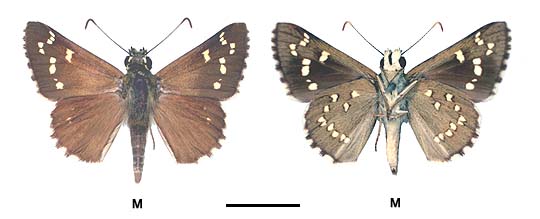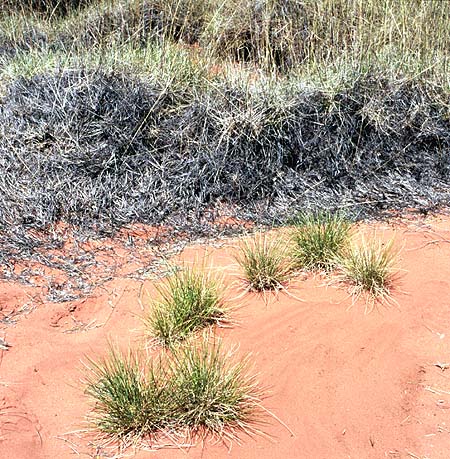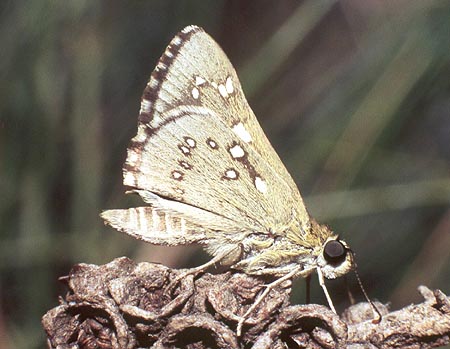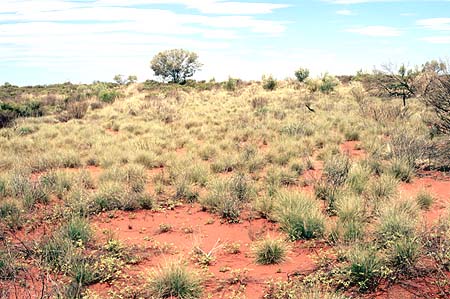-
Larval Food Host
-
Various Triodia species. The only host-plant species growing within South Australia
is T. pungens (resin or soft spinifex) (Poaceae), notable for its
copious resin producing ability that aborigines used in the past. The larvae eat the leaves
of the host-plants. The skipper is particularly partial to new growth on the host-plant,
and skipper populations can briefly proliferate after fire due to host-plant regrowth,
(provided the skipper populations in nearby areas have also not been destroyed by the fire).
This spinifex is low growing and relatively soft and sticky to the touch, whereas other
inland spinifex are large, tussocky, and more memorable for the potent pointed ends of their
leaves that can quickly cripple any wayward adventurer entering into their domain.
-
Eggs
-
Small, nearly hemispherical (domal) shaped, base flat circular, with 22-23 strong,
faintly beaded vertical ribs, and indistinct horizontal inter-ridges. The small
micropylar area on top of the egg is depressed. Pale yellow when newly laid. Laid
singly on the leaves of the hostplants near its base. Eggs start to hatch after 6
days and the egg shell is eaten by the larva after its emergence.
-
Larvae
-
The first instar is long cylindrical, initially pale yellow, with a large shining
black head having a few long hairs, the neck (prothoracic plate) is black. After
eating the empty eggshell the larva will move to near the tips of the leaves to
form a small tubular shelter from two or more leaves.
New shelters are periodically constructed in the outer parts of the hostplant to fit
the growing larvae, using 8-11 leaves in the final shelter utilized by the fourth and
fifth instars. The shelter is narrow, long cylindrical, opening at the bottom that
typifies this tribe of skippers, and the leaves are not twisted to form the shelter.
Some of the leaves are eaten through at the base of the shelter to provide better
larval access to the opening. The shelters are very strongly lined with silk. Larvae
rest and hide from predators within the shelters during the day with their heads
directed towards the base of the hostplant. The growth of the larvae is slow and the
larval period has not been established but is believed to be up to 12 months and
dependant on humidity and rainfall.
The final instar is about 25 mm long. The body colour is semi-translucent blue-green
with a darker dorsal line, and a pale green dorsolateral line. The head is weakly
elongated rectangular shaped, finely rugose, pale brown with a darker brown frontal
vertical mark above the mouth and the posterior edge is also darker brown. There are
some white, depressed, forward directed simple setae. The body, and particularly the
anal plate on the last segment, have some tiny secondary setae. Along the body they
are elongate vase shaped set on transparent simple raised bases. On the anal plate
these setae are similar to those found on sister species
Antipodia atralba and
Herimosa albovenata,
and vary from long stemmed wine-glass shapes, sometimes with a protruding button
extending out from the cup, to simple elongate setae with a knobbed end.
-
Pupae
-
Short cylindrical, about 18-22 mm long, semi-translucent yellowish green, brownish
anteriorly and posteriorly, nearly smooth, with very sparse abdominal bristles.
The posterior end tapers to a short, narrow, bluntly ended, dark brown cremaster.
The head is rounded, with the head cap (operculum) being black coloured. The central
part of the operculum is heavily sclerotised (very rugose) and is divided into a
larger ventral part, and two smaller equal-sized dorsal parts. There are further,
smaller less sclerotised areas lateral to the central part.
Pupation occurs in the final larval shelter on the hostplant, and the larva pupates
head downwards, directed towards the base of the plant. The pupa is secured within
the silk lined shelter by very strong hooked bristles emanating from the end of the
cremaster. The pupal duration is about 12-14 days. The empty pupal case remains inside
the shelter after the adult skipper emerges.
-
Flight Period in South Australia
-
The skipper has been recorded flying throughout the year in tropical areas. Flight in
the cooler southern areas of its range in Australia seems to peak during spring and
again during the monsoon wet season (autumn), and is probably in response to warmth
and rain with the latter promoting a blossoming of nectar plants required by the
adults. In South Australia, males are the first to emerge during the spring flight.

-
Distribution
-
The skipper occurs in tropical and subtropical latitude-areas where its
spinifex host plants grow in adequate density. In South Australia the
hostplant Triodia pungens only occurs in the Far Northwest Region
of the state in the vicinity of Amata to Pipalyatjara and Iltur.
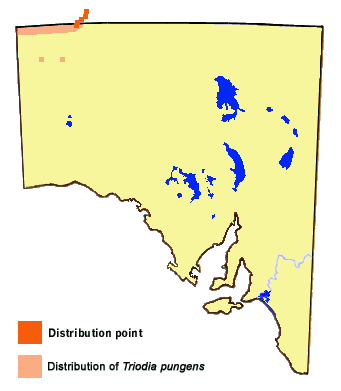
-
Habitat
-
The hostplant Triodia pungens proliferates in red dune habitat where
it is usually the only Triodia species to grow. Such habitat is usually
open, dry woodland or heathland, where the Triodia pungens can often be
the dominant species.
-
Conservation Status in South Australia
-
The hostplants are widely distributed and the skipper can be locally common
when the habitat and conditions are favourable.
-
Threats
-
The main threats are from the effects of fire or extended drought.
The spinifex is inedible to grazing animals and can regenerate
from fire provided it is not too frequent.
-
Conservation Strategy
-
None required. Burnoffs should be local so as not to destroy too large an area
such that skipper populations cannot recover in fragmented habitat areas.
